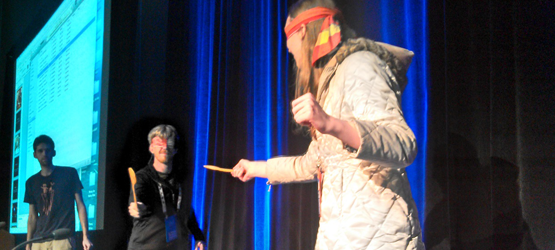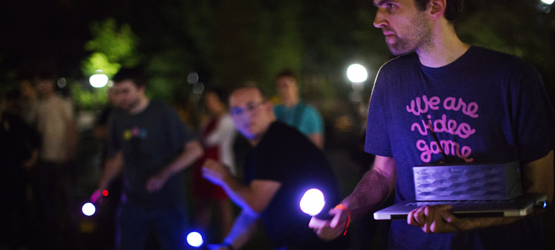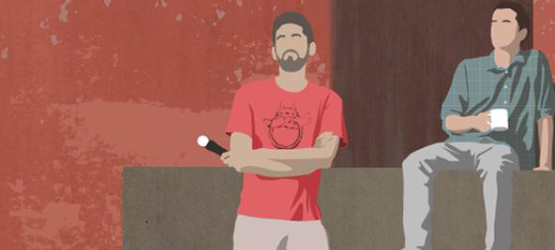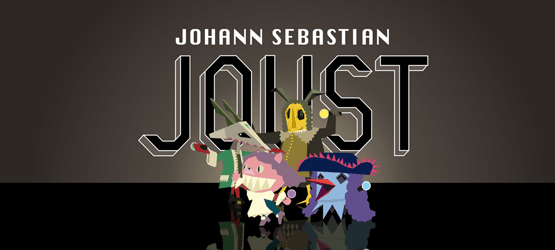Crowdfunding has been an emerging concept over the last few years, and with it we have been seeing significant growth in the indie game scene. One of the best examples of this is the recently released Sportsfriends game on the PS3 and PS4, a title that came into existence because the community took notice of it and supported its development. Even though there are a number of fun titles on the collection, one game has stood out among the rest bringing with it a great deal of attention and that is Johann Sebastian Joust. A digitally ruled physical game similar to tag that was developed by Doug Wilson, who is has taken a few moments to talk about its history, its future and what lies ahead for the man behind the curtain.
Hi Doug, could you tell me where the concept behind Johann Sebastian Joust came from?
Yes, I originally prototyped the game in 2011, which is quite a few years ago at this point. I was a PhD. student at IT University of Copenhagen in Denmark, studying game design from a pretty academic perspective actually. But, I had a background in Computer Science, so I was also jamming on games on the side. With a bunch of colleagues in Copenhagen at the time I was part of the group called the Copenhagen Game Collective and we had been making weird physical games at game jams and installations. We had done this weird, funny, installation piece called Dark Room Sex Game in 2008. It was a no graphics WiiMote game/joke.
From there, I got interested in thinking about video games beyond the screen and physical and public games and using sound and rumble and light and stuff beyond the screen to do physical play. At the same time, as a part of my Ph D. I was studying a bunch of folk and playground games and I found a bunch of that kind of stuff inspiring. Also, as a designer, I was thinking a lot about kids games, playground games and we had been working on a bunch of Wiimote projects and motion control project and physical games. We had made this game called B.U.T.T.O.N. Brutally Unfair Tactics Totally OK Now, which is this crazy physical racing game that was part of the independent games festival in 2011 in Indiecade.

My mind was in that space and in 2011, at the Nordic Game Jam I had this idea of moving in slow motion to music and tying all this stuff together. The game was kind of directly inspired by a danish folk game, by some friends of friends of friends called Listelanse, which means sneaky lance in Danish. How it works is, you play it at a party and you have two people blindfolded and the the first person to hit the other with a wooden spoon wins. But, what stops that from becoming incredibly violent is that they have to move in incredibly slow motion and everyone watching is enforcing the rules. So, if someone starts moving too fast the crowd will start yelling at them.
We often play loud Drum-and-Bass music, one to kind of mask the sound of where your opponent is moving but it also makes it a bad B-Action movie in the making. From that it was like moving in slow motion is performative and fun, but from a game design perspective its useful because it means the motions aren’t quite as physical and violent.
Long answer, but out of that whole milieu is where this initial prototype came from.

What were some of the reasons that it took so long to release Sportsfriends, even though parts of it have been playable at numerous events for some time?
So, I only finished my Ph D. in May of 2012 and until then, Joust was this super side-project and I had shown it at Indiecade and IGF and a bunch of indie festivals in late 2011 and early 2012. But, I didn’t really have that much time to work on it. The original was for the Wiimote in May 2011, I made it for the Move which let me distribute it to other people so they could play off their Mac.
For my part, I wasn’t really working on it. Then come May 2012, I finally finish and get my Ph D. and I have to decide what to do next with my life. By this point J.S. Joust had won a few awards and people were really interested in it, and my friend Niels Daniken had this studio Die Gute Fabrik. He was working on some games and we were like well, we should partner up because I had already worked with him on a bunch of other projects and Iso we could do this full time indie thing.
Also, for the first half of 2012 I had been talking to publishers about J.S., some people had seen it win these awards and at festivals and really liked it. We spent all these months, like in really slow negotiations, these people would take weeks to get back to you and it got pretty far in some negotiations. But, ultimately the game was too weird and it didn’t pan out. In retrospect I wasted too much time, I should have just been like this isn’t going to work out and I should have done it on my own. Eventually I reached that point, and now it was like Summer 2012.

Now, what am I going to do with this thing and at the same time, i’m from New Jersey originally, so even though I was in Denmark, i was coming home to visit family all the time. As a result, I was in New York at the time, and there is this really burgeoning scene here of public games and art institutes showing game and just like getting people in public playing games. So, I had been showing Joust in New York and I had a bunch of friends here, Ramiro Corbetta made Hokra, Noah Sasso made BaraBariBall and their games had been commissioned by NYU for their No Quarter Exhibition. It felt like there was this wave of local multiplayer games coming out and we were all trying to figure out what the heck to do, and could these be commercially viable or will they just be game jam projects forever?
We weren’t interested in online multiplayer and knew that was way outside of our budget. So, even if we wanted to, that wasn’t a financial possibility for us. So, we were like maybe what we can do something like the old Summer Games or Wii Sports, team up and add value to this package, by making an anthology of local multiplayer games. So, that was the idea and meanwhile Nick Suttner from Sony in San Mateo had seen these games at festivals and was a really big fan and we started talking to him. Then, him and his office were interested and so we worked with them and they wanted us to bring it to PlayStation and we Kickstarted it in late 2012 after a long planning period. It is incredibly complicated to run one of those things, but we did it successfully.
All of that long story is to say that, we really only started production in early 2013 and it took us about a little over a year to finish it.




